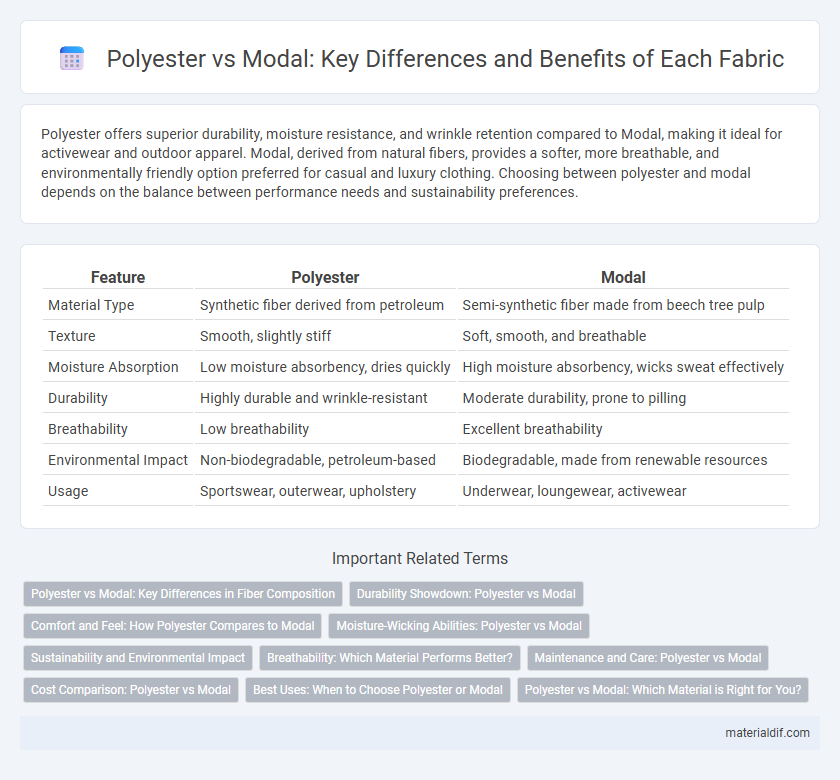Polyester offers superior durability, moisture resistance, and wrinkle retention compared to Modal, making it ideal for activewear and outdoor apparel. Modal, derived from natural fibers, provides a softer, more breathable, and environmentally friendly option preferred for casual and luxury clothing. Choosing between polyester and modal depends on the balance between performance needs and sustainability preferences.
Table of Comparison
| Feature | Polyester | Modal |
|---|---|---|
| Material Type | Synthetic fiber derived from petroleum | Semi-synthetic fiber made from beech tree pulp |
| Texture | Smooth, slightly stiff | Soft, smooth, and breathable |
| Moisture Absorption | Low moisture absorbency, dries quickly | High moisture absorbency, wicks sweat effectively |
| Durability | Highly durable and wrinkle-resistant | Moderate durability, prone to pilling |
| Breathability | Low breathability | Excellent breathability |
| Environmental Impact | Non-biodegradable, petroleum-based | Biodegradable, made from renewable resources |
| Usage | Sportswear, outerwear, upholstery | Underwear, loungewear, activewear |
Polyester vs Modal: Key Differences in Fiber Composition
Polyester is a synthetic fiber derived from petroleum-based polymers, known for its durability and resistance to shrinking and stretching. Modal is a semi-synthetic fiber made from beech tree cellulose, offering superior breathability and a softer, silk-like texture. The key difference lies in their fiber composition: polyester is purely synthetic, while modal blends natural cellulose with chemical processing, impacting comfort and environmental footprint.
Durability Showdown: Polyester vs Modal
Polyester outperforms modal in durability due to its synthetic fibers that resist stretching, shrinking, and wrinkling, making it ideal for long-lasting garments. Modal, a semi-synthetic fabric derived from beech tree pulp, offers a softer feel but tends to be less resistant to abrasion and pilling compared to polyester. For applications demanding high wear resistance and maintenance of shape over time, polyester stands as the superior choice.
Comfort and Feel: How Polyester Compares to Modal
Polyester offers a smooth, durable texture but tends to feel less breathable and slightly stiffer compared to Modal, which is known for its exceptional softness and moisture-wicking properties. Modal's natural cellulosic fibers provide a silky, lightweight feel that enhances comfort, particularly in warm or humid conditions. Polyester is often favored for its resilience and wrinkle resistance, yet Modal excels in delivering a plush, breathable fabric ideal for sensitive skin and everyday wear.
Moisture-Wicking Abilities: Polyester vs Modal
Polyester exhibits superior moisture-wicking abilities compared to modal due to its hydrophobic nature, allowing it to efficiently draw sweat away from the skin and dry quickly. Modal, a semi-synthetic fabric derived from beech tree pulp, tends to absorb more moisture, resulting in slower drying times and less effective moisture management. This moisture-wicking difference makes polyester a preferred choice for activewear and performance garments where staying dry and comfortable is essential.
Sustainability and Environmental Impact
Polyester, a synthetic fiber derived from petroleum, is less sustainable than Modal, which is produced from renewable beech tree pulp and is biodegradable. Polyester's production consumes non-renewable fossil fuels and releases microplastics, contributing significantly to environmental pollution. Modal offers a lower environmental impact with less water and energy use during manufacturing, making it a more eco-friendly fabric choice.
Breathability: Which Material Performs Better?
Polyester, a synthetic fiber, generally offers less breathability compared to modal, which is a semi-synthetic fabric derived from beech tree pulp known for its moisture-wicking properties. Modal excels in allowing air circulation and absorbing moisture, making it more comfortable in warm or humid conditions. Polyester tends to trap heat and moisture, which can lead to reduced comfort and increased sweat retention during physical activities.
Maintenance and Care: Polyester vs Modal
Polyester requires low maintenance due to its resistance to wrinkles, shrinking, and stretching, and it dries quickly, making it ideal for easy-care garments. Modal, while softer and more breathable, demands gentler washing with cold water and avoids high heat drying to maintain fabric integrity and prevent pilling. Both fibers benefit from air drying and using mild detergents, but polyester's durability allows for more frequent washing without losing shape or color.
Cost Comparison: Polyester vs Modal
Polyester is generally more cost-effective than Modal due to its synthetic production process and widespread availability. Modal, derived from beech tree cellulose, tends to be pricier because of its more complex manufacturing and sustainable sourcing. Businesses often choose polyester to minimize expenses while Modal is favored for premium, eco-friendly textile products.
Best Uses: When to Choose Polyester or Modal
Polyester excels in activewear, outdoor gear, and home furnishings due to its moisture-wicking properties, durability, and resistance to shrinking and wrinkles. Modal, derived from beech tree pulp, is best for casual wear and luxury apparel where softness, breathability, and eco-friendly fabric are prioritized. Choose polyester for longevity and performance in high-stress environments, while modal suits garments requiring a smooth, comfortable feel with enhanced absorbency.
Polyester vs Modal: Which Material is Right for You?
Polyester offers durability, moisture-wicking properties, and resistance to wrinkles, making it ideal for activewear and everyday garments. Modal, derived from beech tree pulp, provides superior softness, breathability, and eco-friendliness, favored for loungewear and luxury apparel. Choosing between polyester and modal depends on the desired blend of performance, comfort, and environmental impact for your clothing needs.
Polyester vs Modal Infographic

 materialdif.com
materialdif.com